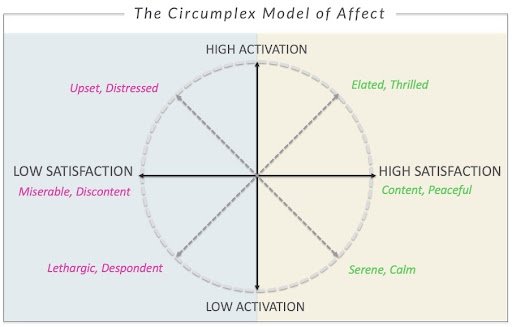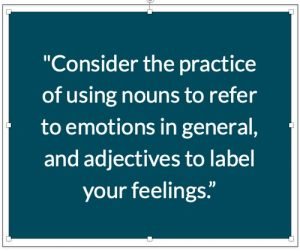In a world where people’s intense emotions are chaotically racing, clashing and gridlocking, how would it feel to experience free-flowing expressways in your communication? How would it feel to have continuous intuitive knowledge about yourself and your surroundings?
Your internal experiences and outward expressions involve systems deep within your nature such as your affect, emotions, thoughts and feelings. These constantly work together to keep you safe and on-course as you move through life.
In this three-part blog series, we will investigate aspects of feelings and how they function, as well as offer tools to help you become consistently unhindered — smarter, quicker and more articulate — when navigating your exchanges with others.

AFFECT: Baseline Light Settings
From birth, you were able to detect simple feedback signals designed with the goal of keeping you alive and helpingyou thrive. The resulting general state is known as your affect. Affect is to emotion what brightness and intensity are to light. Entire vibes are created in a room by adding more lighting, dimming lights or adding strobe lights. In essence, affect is much like mood lighting. It helps you enjoy the general scene and sense when something is needed.
Influenced by your pumping blood, expanding lungs, churning stomach, levels of satisfaction and energy rise and fall, affect is your brain’s fluctuating “how-goes-it?” score. It’s always there, even as you sleep, affecting your physical and perceptual experience — for better or worse. The most basic input to emotion, affect is a combination of two sliding scales:

- Satisfaction (low — high): how well my brain perceives my needs are being met
- Activation (low — high): the intensity of my relative level of arousal
EMOTIONS: From Grayscale to Technicolor
A newborn is only able to focus at a distance of eight to 12 inches, and all objects appear in grayscale. It takes five months to perceive colors — first red, then the others. And so it is with emotions. Even though you noticed degrees of contentment or misery, calmness or distress at birth, you were “affectively” color blind. You lacked the capacity to clearly categorize what you felt. During those early months of being nurtured, spoken to by others and receiving other sensory inputs, your core emotional color tones formed.

What are emotions? Simply put, emotions are impulses to act. They are more specific and short-lived than affect. Crucial to survival, emotions are physiological prompts that take place within the body in relation to a situation (for example: the threat of an oncoming car, or the memory of a sweet encounter). Emotions signal when your needs, such as safety, acceptance and positive outcomes, are met or unmet. They soundlessly call out from within, “Eeek!” “Awww!” “Darn!” “Oops!” and “Yay!” — urging us to scram, sob, scowl, blush or happy dance :).
Since emotions affect your body at a physical level, they are objectively measurable. Science can truly monitor emotion-related brain activity, blood flow, body language and facial micro-expressions. Theorists have debated the number of basic (irreducible) emotions for generations, with four (happiness, sadness, fear and anger) being the conclusion of a 2017 study based on facial expressions.
Emotions are internal signals for action that:
- Build upon and add detail to affect
- Point to underlying needs — whether required or desired
- Precede feelings
Over time, as your brain perceives specific needs being satisfied (or not), it establishes basic emotional concepts such as Peace (needs are/will be met), Fear (needs are threatened) and Sadness (needs are lost/lacking) to more adequately decipher affect. Emotions bring valid and valuable data to light about something that is going on, but it is up to you to accurately verify what that something might be. How you recognize (see Emotional Self-Awareness) and work with your emotions will determine whether their outcomes are helpful or not. So, the next step is learning to feel!
FEELINGS: Shades, Tints and Hues

The goal of feelings is to make you consciously aware of your emotions and, ultimately, to distinguish their attributes. Thus, you can think of an emotion as something you have and a feeling as something you realize. This means an emotion becomes a feeling only at the point when it is consciously felt.
For the sake of clarity, consider the practice of using nouns to name emotions in general and adjectives to label your feelings. As an example:
- I become aware of the emotion sadness (noun).
- I feel sad (adjective).
In order to realize a feeling, your brain must sense an emotion and assign it with meaning. Thus, while emotions play out in the body, feelings play out in the brain. Thoughts serve as a link between the two. In a later blog, we will discuss thoughts and their crucial role in the interpretation, verification and regulation of feelings. But now, let us simply trace the flow of the above-mentioned elements from start to finish.
A situation affects you →
you have emotion (charged with adrenaline, rising heart rate, etc) →
you realize you are feeling the emotion →
your brain interprets its meaning: “I feel afraid.”

Feelings often last longer than emotions and are learned. But for many people, connecting their emotions and feelings is a tremendous challenge. You may have an emotion without knowing about it or without having a word for it. Meanwhile, the emotion is there — clearly, even if unconsciously, displayed through your behavior.
This short-circuit can happen for a variety of reasons, but the good news is that through practice, you can learn to accurately read, classify and attentively regulate the signals. Studying which emotions are associated with which situations will equip you with discernable feeling constructs. Meanwhile, your brain, constantly in the process of categorization, will continue to auto-combine past experiences in novel ways to develop subtle new shades of feelings. The spectrum expands in this manner as a by-product of intentional nurture and instinctive nature.
To illustrate, the color cyan is a shade of blue made by mixing green light with primary blue. And in a similar way, pure sadness feels distinct from sadness mixed with shame (remorse). Additionally, feelings present different levels of intensity, such as upbeat vs. euphoric. The more finely grained your vocabulary, the more precisely you can communicate. Words enable you to conceptualize and differentiate feelings with precision and efficiency, just like the labels that have taken our world from the four-pack box of crayons to that brilliant 120-count box. How did we ever live without knowing cerulean blue?
FALSE-FEELINGS: Purple Caution Lights

In digital imaging, false-colors depict an object in colors that differ from what an observer would see to enhance or intensify details: A yellow warning light might appear purple, a green tree as orange and so on. Similarly, we can re-color and represent our feelings as pseudo- or false-feelings.
False-feelings are feelings infused with subconscious demands, opinions, attitudes or assumptions. Without awareness they can cover up and misguide our very real emotions, often out of conditioning or as a way of self-protection. These can be especially dangerous when containing messages about yourself or others.
How do you detect and examine false-feelings?
- False-feelings hide in phrases that begin with “I feel” followed by “that,” “like,” “as if,” or pronouns. For example, “I feel like a loser,” “I feel it is useless,” or “I feel that you are unfair.”
- Beware of using past participles of verbs that label what you think others have done to you: “I feel “rejected,” “used,” “harassed,” smothered,” “cut off” “forgotten“ or “unheard.” While this may be your interpretation of the situation (and an accurate one at that), these are not primary feeling words.
Judgments are very hard to discern from feelings, especially if you have internalized a misleading self-view: “I feel faulty,” or “I feel inadequate.” When you’ve felt a secondary emotion like anger or shame, pause for a moment and redirect yourself to the primary emotion and its source.
While widely practiced, using the word feel without actually expressing an emotion is a careless use of the English language. Instead, slow down, back up to where you originally felt the emotional signal in your body, and identify its core. If you cannot point to where you felt the signal, you are probably not expressing a true feeling, but rather a thought.
ON THE ROAD: Expressing Via True Colors
According to renowned peace activist Dr. Marshall Rosenberg, the ability to accurately pinpoint your feelings and their underlying needs is crucial to life-affirming communication flow. This is especially vital at those difficult relational intersections where loss, shame and uncertainty can lead to traffic jams and road rage.
To promote freedom in your self- and interpersonal relating, consider intentionally following these two feelings “express ways” until they become automatic:
- When communicating, make it a point to begin expressions of emotion with “I felt _____. ” or “I feel_______.” Fill in the blank with a feeling word. Make sure to identify the original signal. You can download this Feelings List Resource to help you name your core feelings and redirect false-feelings.
- Begin to identify the needs beneath your feelings using this Needs List Resource, which will be featured in more detail in our next blog. Meanwhile, you can find Dr. Rosenburg’s framework for compassionate communication here.
We hope these tips and checklists help you to read the valuable internal signals as you are maneuvering your day-to-day relational roadways. Happy traveling until we meet again.
